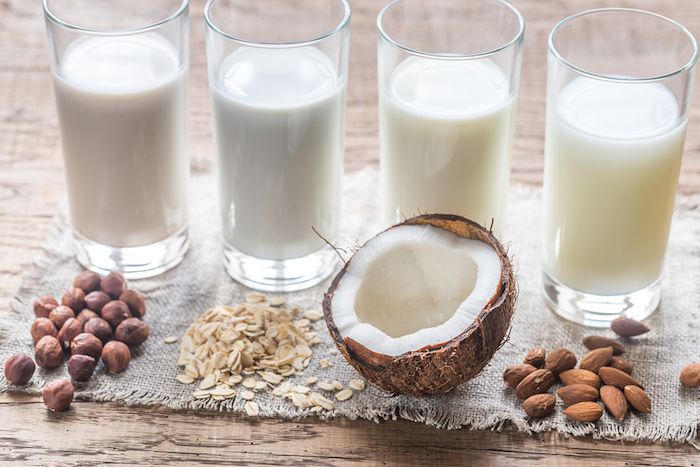
I’ve been mostly dairy-free for about five years and I can’t imagine ever going back.
Once I gave up dairy, my skin cleared up, my pants felt looser, and my seasonal allergy symptoms dissipated. These days I consider myself “mostly dairy-free” because I find that I tolerate a high-quality goat cheese or raw cheese just fine about once per week, but in general, all of my food is diary-free.
Why dairy-free?
Some studies indicate that dairy is addictive. We know for sure that during digestion, a protein found in dairy products called casein releases opiates called casomorphins. "[Casomorphins] really play with the dopamine receptors and trigger that addictive element," registered dietitian Cameron Wells told Mic.
Personally, the clearer skin, looser pants, and allergy symptom relief are pretty much the best reasons to go dairy-free, but those reasons are of course anecdotal. There’s still debate in the nutrition community as to whether diary causes those issues, but I always tell my clients that it’s case by case. If going dairy-free relieves your symptoms, then do what works best for you.
Dairy is used as an additive in most packaged foods that don’t look like they contain milk, cheese or butter. Learning how to navigate a dairy-free lifestyle and where dairy hides will help you be in control of your diary consumption.
For me, I look at diary as an occasional treat and have established a small “dairy allowance” in my diet. And believe me, I’m going to enjoy that allowance on a wonderful aged raw cheese, not in my daily coffee or a whey protein smoothie.
1. Choose vegan food, even if you’re not vegan.
You don’t have to be a full-time vegan, but choosing vegan options will guarantee no dairy in your food. Look for vegan recipes and foods labeled vegan at the grocery store.
You can even choose a vegan dish and add your choice of a lean protein, like fish or chicken. That of course isn’t vegan, but you can be certain it’s dairy-free.
2. Become a label detective.
Learn words that indicate dairy and read all labels. Milk, butter, cheese, and cream are pretty obvious, but food manufacturers often “hide” dairy ingredients by using different names. The two most common are whey, lactose, and casein derivatives. Here is a great resource of dairy ingredients.
In packaged food like crackers and chips, dairy ingredients should be indicated in one of two ways according to the Food Allergen Labeling And Consumer Protection Act of 2004. Milk should be listed in parentheses next to the ingredient, like "whey (milk)”, or the end of the ingredients label should indicate “Contains: Milk.” Always look for these statements, though, it’s not foolproof as foods do not have to pass specific audits before going to market.
3. Eat more whole foods.
Since there are hundreds of food additives that contain dairy ingredients, choose whole foods and foods with short labels. The less ingredients, the less likely there is hidden diary in your food. Because things like fast food are so highly processed, almost every menu item will contain a dairy derivative (even though it appears to contain no dairy.)
4. Learn restaurant secrets before dining out.
Dining out is a wonderful occasional treat. Many chain restaurants simply heat up packaged food in the back and put it on a plate, so they really don’t have a lot of control over ingredients. Choose restaurants where the kitchen prepares each meal from scratch and let your server know you don’t consumer diary.
To make food more appealing to an American audience, restaurants often add butter, cream, or cheese to dishes even when those ingredients are not listed on the menu.
For instance, many Thai restaurants add heavy cream to curry dishes made with coconut milk. It appears to be dairy-free on the menu, but when it arrives at the table it contains heavy cream or other dairy derivatives. Just be sure to always ask. Similarly, many restaurants might add a sprinkle of parmesan to fries and don’t list it on the menu (they also add flour to make them crispier, so if you’re gluten-free check on that, too).
Most places that make your food from scratch are happy to prepare your meal without dairy when you request it. Just be clear with your server and ask if they can accommodate your dairy-free lifestyle.
5. Embrace nut milk & seed milk.
Homemade nut milk, like almond milk, is a wonderful substitution for diary milk in most recipes. It’s great in coffee, on cereal, in overnight oats or oatmeal, or just plain on its own.
If you have to purchase nut milk just be sure it doesn’t contain carrageenan as it’s been shown to irritate the lining of the gut and may cause inflammation. It’s also best to choose the unsweetened varieties to keep your sugar consumption low.
If you’re allergic to nuts, try hemp seed or pumpkin seed milk, both are delicious.
Coconut milk is another wonderful alternative; choose canned coconut milk in BPA-free cans with no added ingredients. The canned varieties tend to to be more pure and have less additives than the cartons you’ll find in the regular milk section.
Cashew cream is also a wonderful dairy-free staple for thickening sauces and other dishes.
And finally, avoid highly processed “dairy replacements” like soy-based cheese and artificially colored processed cheese product. While they don’t contain dairy, they’re not helping your health in any way.
I spent years perfecting my dairy-free whole-food based cheese sauce, join me in my kitchen and learn to make it step-by-step on my cooking show Elizabeth Eats. Each episode contains a dairy-free recipe that’s so good you won’t even miss the dairy.
Have you tried a dairy-free lifestyle? What works for you? Share your experiences in the comments below to help other readers on their diary-free journeys.
